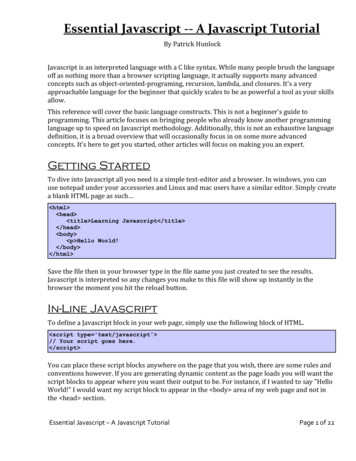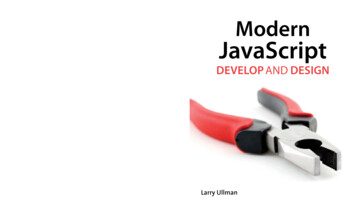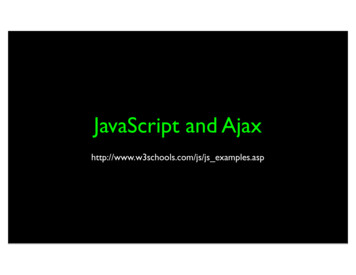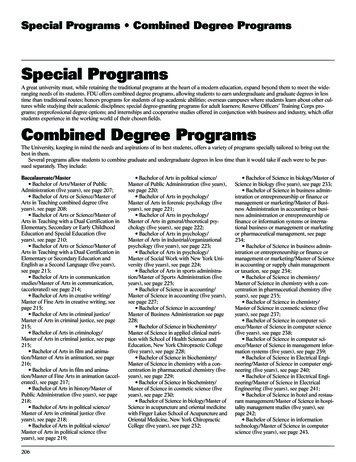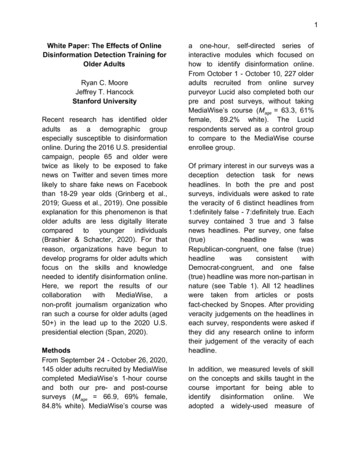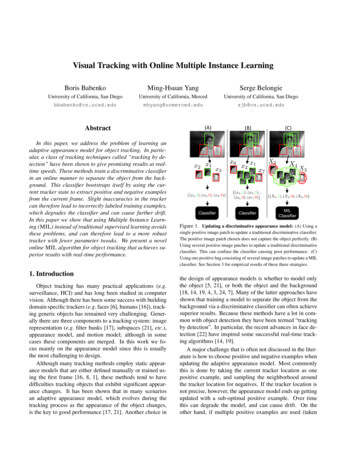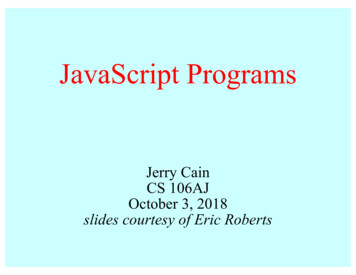
Transcription
JavaScript ProgramsJerry CainCS 106AJOctober 3, 2018slides courtesy of Eric Roberts
Once upon a time . . .
The World Wide Web One of the strengths of JavaScript is itsintegration with the World Wide Web,which was invented by Tim Berners-Leeat the CERN laboratory in Switzerlandin 1989. In honor of his contributions to the web,Berners-Lee received the Turing Awardin 2016. Named after computer scientistAlan Turing, the Turing Award is thehighest honor in the computing field.Tim Berners-Lee (1955–) The ideas behind the the World Wide Web have a long historythat begins before the computing age. Contributors to the ideaof a world-wide interconnected repository of data include theBelgian bibliographer Paul Otlet, the MIT-based engineer andscientist Vannevar Bush, and computer visionary Ted Nelson.
JavaScript Programs
The "Hello World" Program In Monday’s class, you learned how to execute JavaScriptfunctions in the console window. Today, your goal is to learnhow to create and execute a complete JavaScript program. In 1978, Brian Kernighan and TuringAward winner Dennis Ritchie wrotethe reference manual for the Cprogramming language, one of theforerunners of JavaScript. On the first page of their book, theauthors suggest that the first step inlearning any language is to write asimple program that prints the words"hello, world" on the display. Thatadvice remains sound today.1.1 Getting StartedThe only way to learn a new programminglanguage is to write programs in it. The firstprogram to write is the same for all languages:Print the wordshello, worldThis is the big hurdle; to leap over it you have tobe able to create the program text somewhere,compile it, load it, run it, and find out where youroutput went. With these mechanical detailsmastered, everything else is comparatively easy.In C, the program to print “hello, world” is#include stdio.h main() {printf("hello, world");}
HelloWorld in JavaScript The code for the HelloWorld program in JavaScript is similarto the C version from 1978 and looks like this:function HelloWorld () {console.log("hello, world");}The HelloWorld function asks JavaScript to display the string"hello, world" on the console log. So far, so good. From here, you need to do the following things:– Learn how to store this function in a file.– Understand how to get JavaScript to execute the function.– Figure out where the output goes. These steps are different in JavaScript than they are in mostlanguages because JavaScript relies on a web-based model.
The Web’s Client-Server Modelclient browserweb serverhttp://cs106aj.stanford.eduindex.htmlO1. The user starts a web browser.2. The user requests a web page.3. The browser sends a network request for the page.4. The server sends back a text file containing the HTML.5. The browser interprets the HTML and renders the page image.
The Three Central Web Technologies Modern web pages depend on three technological tools:HTML (Hypertext Markup Language), CSS (Cascading StyleSheets), and JavaScript. These tools are used to control different aspects of the page:– HTML is used to specify content and structure.– CSS is used to control appearance and formatting.– JavaScript is used to animate the page. You will have a chance to learn even more about HTML andCSS later in the quarter. For now, all you need to know ishow to write a simple index.html file that will read andexecute your JavaScript code.
The Structure of an HTML File An HTML file consists of the text to be displayed on thepage, interspersed with various commands enclosed in anglebrackets, which are known as tags. HTML tags usually occur in pairs. The opening tag beginswith the name of the tag. The corresponding closing tag hasthe same name preceded by a slash. The effect of the tagapplies to everything between the opening and closing tag. The only HTML tags you will need to use for most of thecourse appear in the template on the next page, whichdescribes the structure of the HTML index file, which isconventionally called index.html.
Standard index.html Pattern The following components of index.html are standardized:– Every file begins with a !DOCTYPE html tag– The entire content is enclosed in html and /html tags.– The file begins with a head section that specifies the titleand JavaScript files to load.– The file includes a body section that specifies the page. !DOCTYPE html html head title title of the page /title One or more script tags to load JavaScript code. /head body onload "function()" Contents of the page, if any. /body /html
Creating the JavaScript Program File The first step in running a JavaScript program is creating afile that contains the definitions of the functions, along withcomments that give human readers a better understanding ofwhat the program does. Here, for example, is the complete HelloWorld.js file:/** File: HelloWorld.js* ------------------* This program displays "hello, world" on the console. It* is inspired by the first program in Brian Kernighan and* Dennis Ritchie's classic book, The C Programming Language.*/function HelloWorld() {console.log("hello, world");}
Creating the HTML File (Version 1) A simple HTML file that loads the HelloWorld.js programlooks like this: !DOCTYPE html html head title Hello World /title script type "text/javascript" src "HelloWorld.js" /script /head body onload "HelloWorld()" /body /html This file asks the browser to load the file HelloWorld.js andthen call the function HelloWorld once the page is loaded. The problem with this strategy is that it is hard "to find outwhere your output went" as Kernighan and Ritchie advise.
Creating the HTML File (Version 2) The output from the console log appears in different places indifferent browsers and usually requires the user to take someexplicit action before it is visible. To make the console log easier to find, we have provided alibrary called JSConsole.js that redirects the console log toa much more visible area of the web page. !DOCTYPE html html head title Hello World /title script type "text/javascript" src "JSConsole.js" /script script type "text/javascript" src "HelloWorld.js" /script /head body onload "HelloWorld()" /body /html
Simple Graphics In addition to JSConsole.js, CS 106AJ also supports alibrary called JSGraphics.js that makes it easy to writegraphical programs. The structure of the index.html file for graphics programs issimilar to the one used for HelloWorld. The BlueRectangleprogram introduced later uses the following index.html: !DOCTYPE html html head title Blue Rectangle /title script type "text/javascript" src "JSGraphics.js" /script script type "text/javascript" src "BlueRectangle.js" /script /head body onload "BlueRectangle()" /body /html
The Graphics Model The JSGraphics.js library uses a graphics model based onthe metaphor of a collage. A collage is similar to a child’s felt board that serves as abackdrop for colored shapes that stick to the felt surface. Asan example, the following diagram illustrates the process ofadding a blue rectangle and a red oval to a felt board: Note that newer objects can obscure those added earlier. Thislayering arrangement is called the stacking order.
The BlueRectangle Programfunction BlueRectangle() {let gw GWindow(500, 200);let rect GRect(150, 50, 200, .add(rect);}rectBlueRectangle
The JavaScript Coordinate SystemBlueRectangle(0, 0)pixels100 pixels(150, 50)200 pixels Positions and distances on the screen are measured in terms ofpixels, which are the small dots that cover the screen. Unlike traditional mathematics, JavaScript defines the originof the coordinate system to be in the upper left corner. Valuesfor the y coordinate increase as you move downward.
Systems of Classification In the mid-18th century, theScandinavian botanist Carl Linnaeusrevolutionized the study of biologyby developing a new system forclassifying plants and animals in away that revealed their structuralrelationships and paved the way forDarwin’s theory of evolution acentury later. Linnaeus’s contribution was torecognize that organisms fit into ahierarchy in which the placement ofindividual species reflects theiranatomical similarities.Carl Linnaeus (1707–1778)
Biological Class HierarchyLiving lluscaChordataArachnidaHymenopteraEvery red ant is also an animal,an arthropod, and an insect, aswell as the other superclasses inthe assification of the red antIridomyrmex purpureus
Instances vs. PatternsDrawn after you, you pattern of all those.—William Shakespeare, Sonnet 98 In thinking about any classification scheme—biological orotherwise—it is important to draw a distinction between aclass and specific instances of that class. In the most recentexample, the designation Iridomyrmex purpureus is not itselfan ant, but rather a class of ant. There can be (and usuallyare) many ants, each of which is an individual of that class. Each of these fire ants is an instance of a particular class ofants. Each instance is of the species purpureus, the genusIridomyrmex, the family Formicidae (which makes it an ant),and so on. Thus, each ant is not only an ant, but also aninsect, an arthropod, and an animal.
The GObject Hierarchy The classes that represent graphical objects form a hierarchy,part of which looks like this:GObjectGRectGOvalGLine The GObject class represents the collection of all graphicalobjects. The three subclasses shown in this diagram correspond toparticular types of objects: rectangles, ovals, and lines. AnyGRect, GOval, or GLine is also a GObject.
Creating a GWindow Object The first step in writing a graphical program is to create awindow using the following function declaration, where widthand height indicate the size of the window:let gw GWindow(width, height); The following operations apply to a GWindow object:gw.add(object)Adds an object to the window.gw.add(object, x, y)Adds an object to the window after first moving it to (x, y).gw.remove(object)Removes the object from the window.gw.getWidth()Returns the width of the graphics window in pixels.gw.getHeight()Returns the height of the graphics window in pixels.
Operations on the GObject Class The following operations apply to all GObjects:object.getX()Returns the x coordinate of this object.object.getY()Returns the y coordinate of this object.object.getWidth()Returns the width of this object.object.getHeight()Returns the height of this object.object.setColor(color)Sets the color of the object to the specified color. All coordinates and distances are measured in pixels. Each color is a string, such as "Red" or "White". The namesof the standard colors are defined in Figure 4-5 on page 125.
Drawing Geometrical ObjectsFunctions to create geometrical objects:GRect( x, y, width, height)Creates a rectangle whose upper left corner is at (x, y) of the specified size.GOval( x, y, width, height)Creates an oval that fits inside the rectangle with the same dimensions.GLine( x0, y0, x1, y1)Creates a line extending from (x0, y0) to (x1, y1).Methods shared by the GRect and GOval classes:object.setFilled( fill)If fill is true, fills in the interior of the object; if false, shows only the outline.object.setFillColor( color)Sets the color used to fill the interior, which can be different from the border.
The GRectPlusGOval Programfunction GRectPlusGOval() {let gw GWindow(500, 200);let rect GRect(150, 50, 200, .add(rect);let oval GOval(150, 50, 200, tgw.add(oval);}GRectPlusGOvaloval
The DrawDiagonals Program/* Constants */const GWINDOW WIDTH 500;const GWINDOW HEIGHT 200;function DrawDiagonals() {let gw GWindow(GWINDOW WIDTH, GWINDOW HEIGHT);gw.add(GLine(0, 0, GWINDOW WIDTH, GWINDOW HEIGHT));gw.add(GLine(0, GWINDOW HEIGHT, GWINDOW WIDTH, 0));}DrawDiagonals
The End
Sheets), and JavaScript. These tools are used to control different aspects of the page: –HTML is used to specify content and structure. –CSS is used to control appearance and formatting. –JavaScript is used to animate the page. You will have a chance to learn even more about HTML and CSS later in the quarter. For now, all you need .
